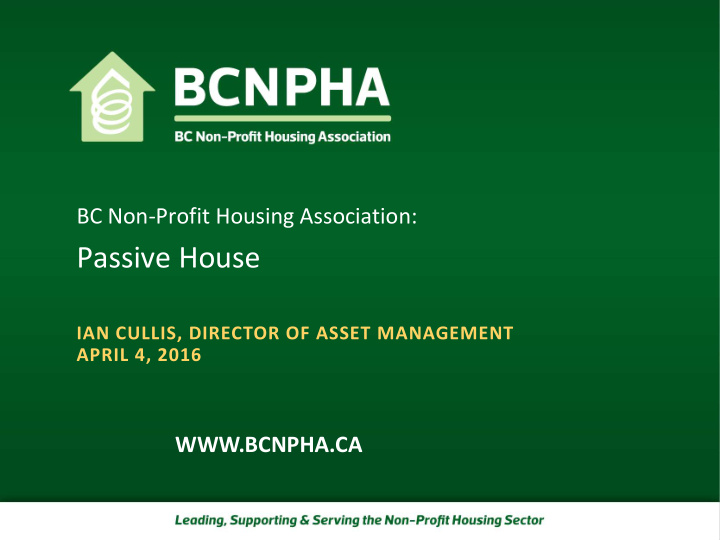



BC Non-Profit Housing Association: Passive House IAN CULLIS, DIRECTOR OF ASSET MANAGEMENT APRIL 4, 2016 WWW.BCNPHA.CA
Energy Efficiency Drivers • Climate Change - Remove human driver • Economy - Energy security 2
Household GHG Emission Sources 3
Non-Profit Sector Energy Use 2 0 0 9 Sector Energy Use Breakdow n [ comparison in equivalent GWh of energy purchased] Res. Electricity 13% Com. Electricity Com. Gas 13% 67% Res. Gas 7% 4
Non-Profit Sector Energy Costs 2 0 0 9 Sector Energy Cost Breakdow n Res. Electricity Cost 23% Com. Gas Cost 55% Com. Electricity Cost 16% Res. Gas Cost 6% 5
Non-Profit Sector Opportunity • Buildings in the sector are ageing • Many societies are considering redevelopment (40+) 600 mixe d use to wnho me 500 a pa rtme nt Numbe r of Prope rtie s 400 duple x sing le de ta c he d 300 200 100 0 pre -1930 1930's + 1940's 1950's 1960's 1970's 1980's 1990's 2000 a nd unspe c ifie d ne we r 6
Municipalities • City of Vancouver – Greenest City Action Plan – Reduce new home energy use by 33% by 2020 – New buildings carbon neutral by 2030 – How will this be achieved? 7
BC Housing Policies • Livegreen – Housing Sustainability Plan – Integrated Decisions – Housing Excellence – Change Agent – How to achieve (owned + operated retrofits completed) 8
BC Government Policies • British Columbia – Climate Action Plan – Reduce GHG emissions by 33% by 2020 – Engagement in early 2016 (what’s next) Benchmarking? Reporting? Mandatory building retrofits? Passive House certification? 9
Recommend
More recommend